前面我通過一篇文章講述了如何爬取CSDN的博客摘要等信息。通常,在使用Selenium爬蟲爬取數據後,需要存儲在TXT文本中,但是這是很難進行數據處理和數據分析的。這篇文章主要講述通過Selenium爬取我的個人博客信息,然後存儲在數據庫mysql中,以便對數據進行分析,比如分析哪個時間段發表的博客多、結合WordCloud分析文章的主題、文章閱讀量排名等。
這是一篇基礎性的文章,希望對您有所幫助,如果文章中出現錯誤或不足之處,還請海涵。下一篇文章會簡單講解數據分析的過程。
一. 爬取的結果
爬取的地址為:http://blog.csdn.net/Eastmount

爬取並存儲至MySQL數據庫的結果如下所示:
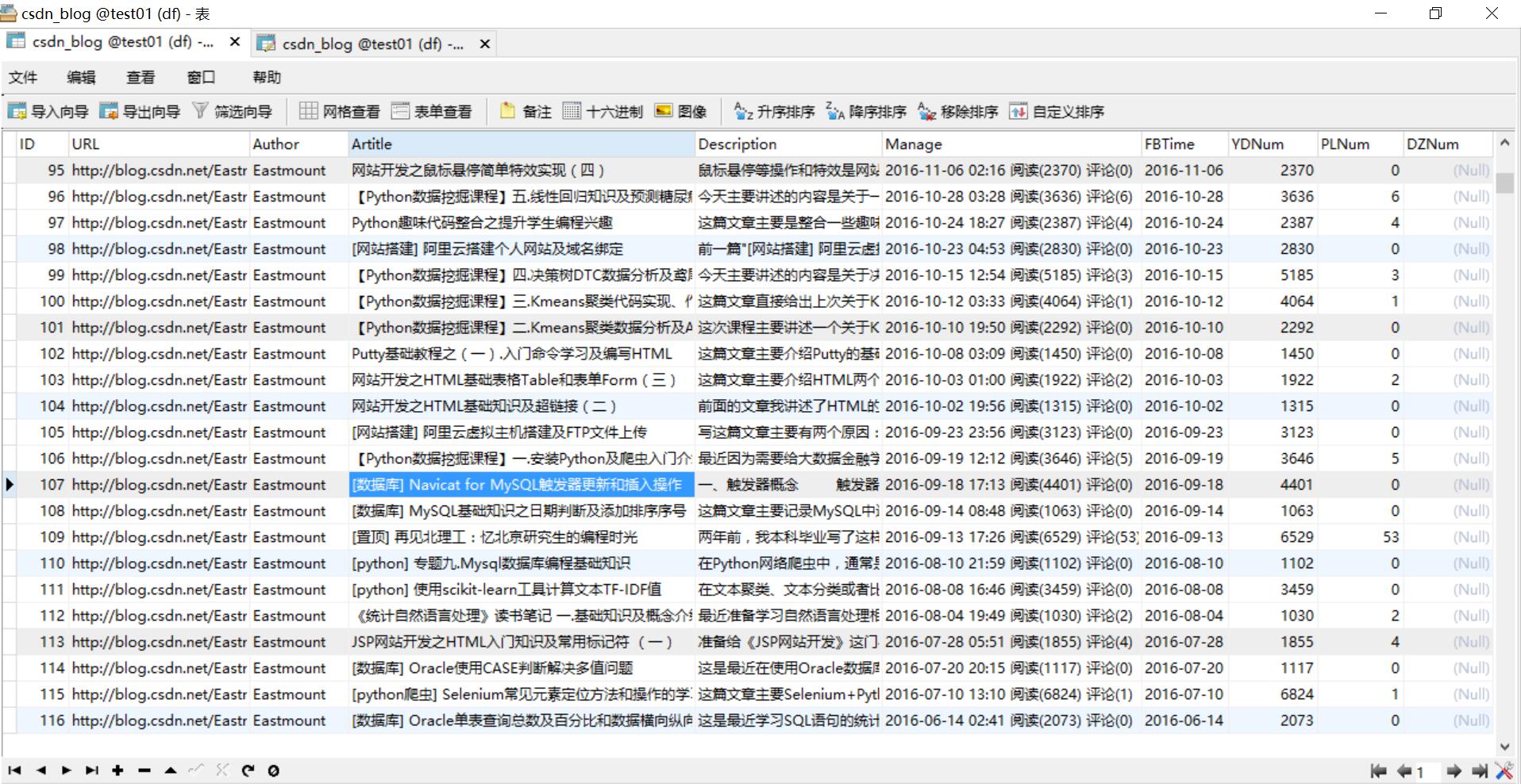
運行過程如下圖所示: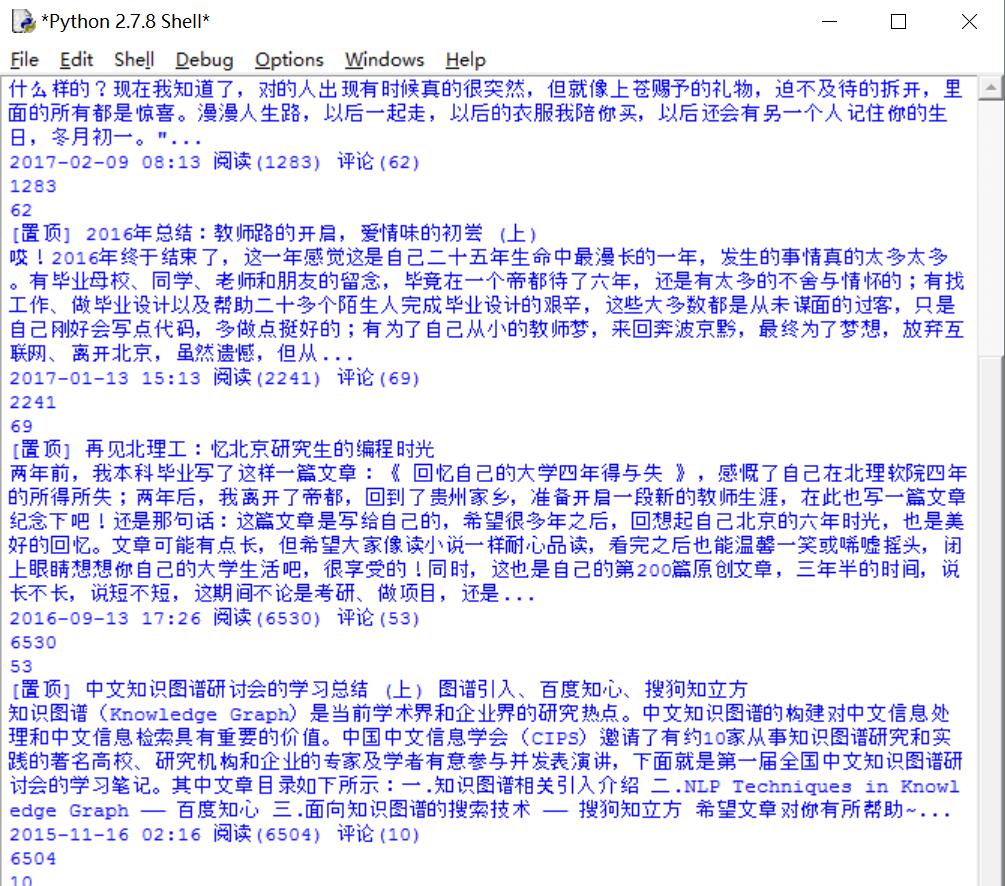
二. 完整代碼分析
完整代碼如下所示:
# coding=utf-8
from selenium import webdriver
from selenium.webdriver.common.keys import Keys
import selenium.webdriver.support.ui as ui
import re
import time
import os
import codecs
import MySQLdb
#打開Firefox瀏覽器 設定等待加載時間
driver = webdriver.Firefox()
wait = ui.WebDriverWait(driver,10)
#獲取每個博主的博客頁面低端總頁碼
def getPage():
print 'getPage'
number = 0
texts = driver.find_element_by_xpath("//div[@id='papelist']").text
print '頁碼', texts
m = re.findall(r'(\w*[0-9]+)\w*',texts) #正則表達式尋找數字
print '頁數:' + str(m[1])
return int(m[1])
#主函數
def main():
#獲取txt文件總行數
count = len(open("Blog_URL.txt",'rU').readlines())
print count
n = 0
urlfile = open("Blog_URL.txt",'r')
#循環獲取每個博主的文章摘信息
while n < count: #這裏爬取2個人博客信息,正常情況count個博主信息
url = urlfile.readline()
url = url.strip("\n")
print url
driver.get(url)
#獲取總頁碼
allPage = getPage()
print u'頁碼總數為:', allPage
time.sleep(2)
#數據庫操作結合
try:
conn=MySQLdb.connect(host='localhost',user='root',
passwd='123456',port=3306, db='test01')
cur=conn.cursor() #數據庫遊標
#報錯:UnicodeEncodeError: 'latin-1' codec can't encode character
conn.set_character_set('utf8')
cur.execute('SET NAMES utf8;')
cur.execute('SET CHARACTER SET utf8;')
cur.execute('SET character_set_connection=utf8;')
#具體內容處理
m = 1 #第1頁
while m <= allPage:
ur = url + "/article/list/" + str(m)
print ur
driver.get(ur)
#標題
article_title = driver.find_elements_by_xpath("//div[@class='article_title']")
for title in article_title:
#print url
con = title.text
con = con.strip("\n")
#print con + '\n'
#摘要
article_description = driver.find_elements_by_xpath("//div[@class='article_description']")
for description in article_description:
con = description.text
con = con.strip("\n")
#print con + '\n'
#信息
article_manage = driver.find_elements_by_xpath("//div[@class='article_manage']")
for manage in article_manage:
con = manage.text
con = con.strip("\n")
#print con + '\n'
num = 0
print u'長度', len(article_title)
while num < len(article_title):
#插入數據 8個值
sql = '''insert into csdn_blog
(URL,Author,Artitle,Description,Manage,FBTime,YDNum,PLNum)
values(%s, %s, %s, %s, %s, %s, %s, %s)'''
Artitle = article_title[num].text
Description = article_description[num].text
Manage = article_manage[num].text
print Artitle
print Description
print Manage
#獲取作者
Author = url.split('/')[-1]
#獲取閱讀數和評論數
mode = re.compile(r'\d+\.?\d*')
YDNum = mode.findall(Manage)[-2]
PLNum = mode.findall(Manage)[-1]
print YDNum
print PLNum
#獲取發布時間
end = Manage.find(u' 閱讀')
FBTime = Manage[:end]
cur.execute(sql, (url, Author, Artitle, Description, Manage,FBTime,YDNum,PLNum))
num = num + 1
else:
print u'數據庫插入成功'
m = m + 1
#異常處理
except MySQLdb.Error,e:
print "Mysql Error %d: %s" % (e.args[0], e.args[1])
finally:
cur.close()
conn.commit()
conn.close()
n = n + 1
else:
urlfile.close()
print 'Load Over'
main()
在Blog_Url.txt文件中放置需要爬取用戶的博客地址URL,如下圖所示。註意在此處,作者預先寫了個爬取CSDN所有專家的URL代碼,這裏為訪問其他人用於提升閱讀量已省略。
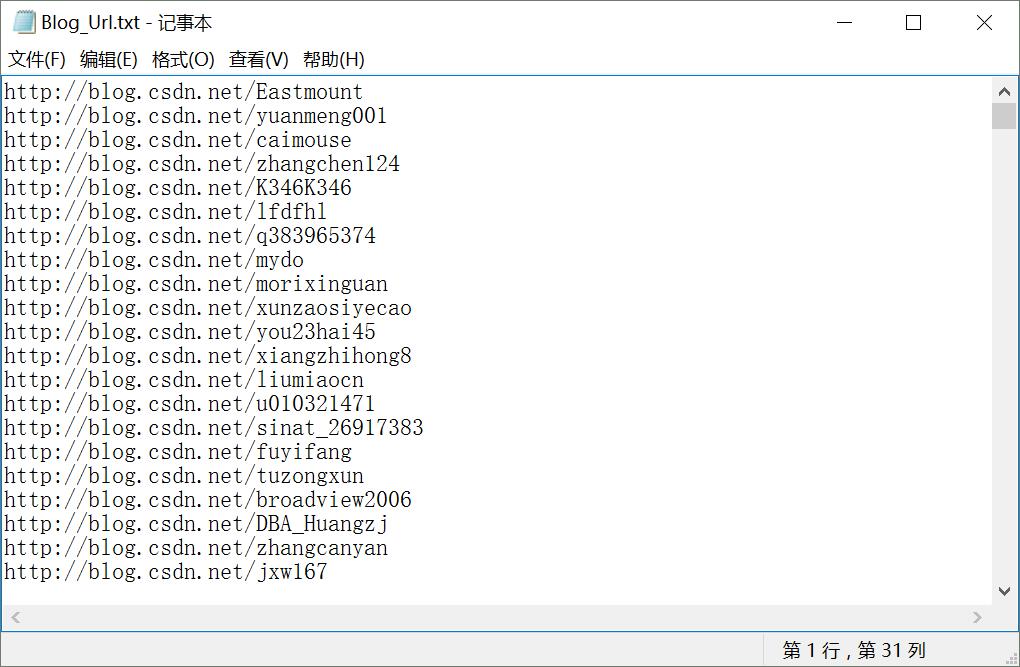
分析過程如下所示。
1.獲取博主總頁碼
首先從Blog_Url.txt讀取博主地址,然後訪問並獲取頁碼總數。代碼如下:
#獲取每個博主的博客頁面低端總頁碼
def getPage():
print 'getPage'
number = 0
texts = driver.find_element_by_xpath("//div[@id='papelist']").text
print '頁碼', texts
m = re.findall(r'(\w*[0-9]+)\w*',texts) #正則表達式尋找數字
print '頁數:' + str(m[1])
return int(m[1])
比如獲取總頁碼位17頁,如下圖所示: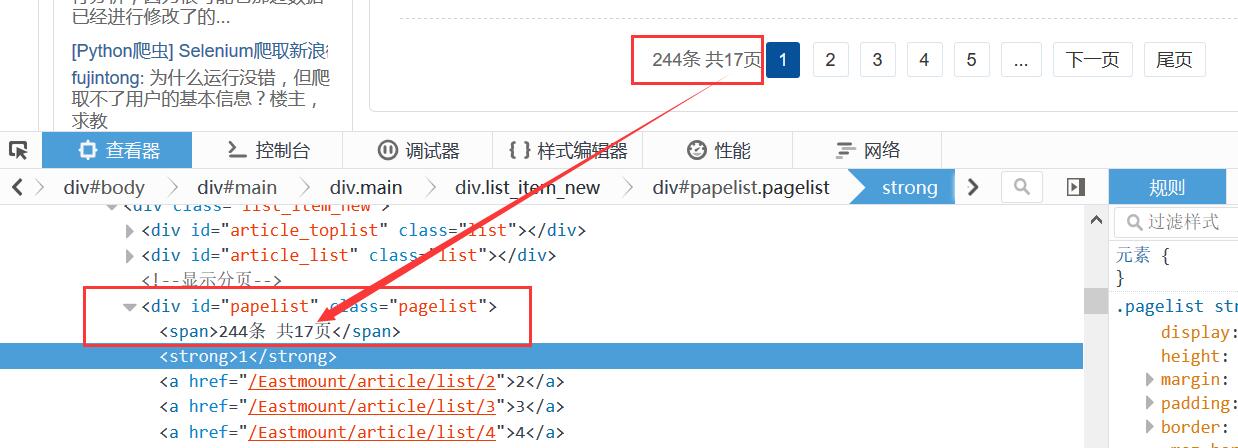
2.翻頁DOM樹分析
這裏的博客翻頁采用的是URL連接,比較方便。
如:http://blog.csdn.net/Eastmount/article/list/2
故只需要 :1.獲取總頁碼;2.爬取每頁信息;3.URL設置進行循環翻頁;4.再爬取。
也可以采用點擊"下頁"跳轉,沒有"下頁"停止跳轉,爬蟲結束,接著爬取下一個博主。

3.獲取詳細信息:標題、摘要、時間
然後審查元素分析每個博客頁面,如果采用BeautifulSoup爬取會報錯"Forbidden"。
發現每篇文章都是由一個<div></div>組成,如下所示,只需要定位到該位置即可。
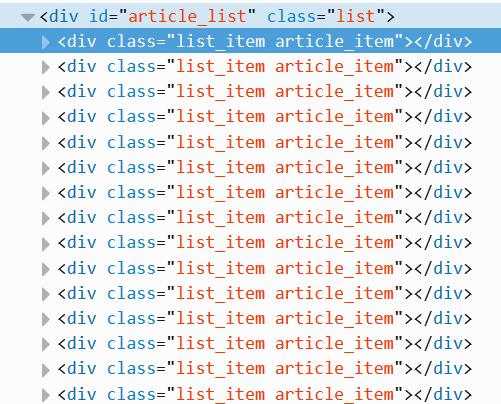
這裏定位到該位置即可爬取,這裏需要分別定位標題、摘要、時間。
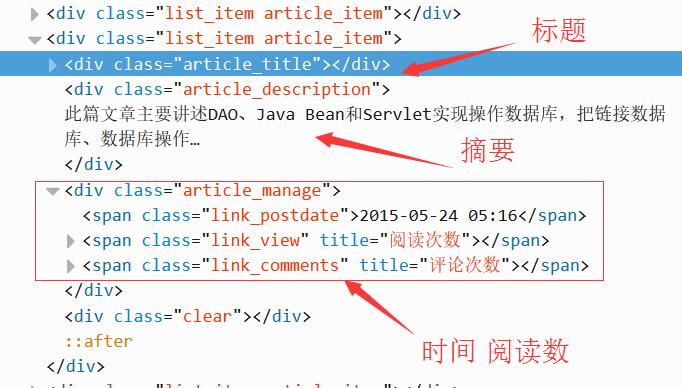
代碼如下所示。註意,在while中同時獲取三個值,它們是對應的。
#標題
article_title = driver.find_elements_by_xpath("//div[@class='article_title']")
for title in article_title:
con = title.text
con = con.strip("\n")
print con + '\n'
#摘要
article_description = driver.find_elements_by_xpath("//div[@class='article_description']")
for description in article_description:
con = description.text
con = con.strip("\n")
print con + '\n'
#信息
article_manage = driver.find_elements_by_xpath("//div[@class='article_manage']")
for manage in article_manage:
con = manage.text
con = con.strip("\n")
print con + '\n'
num = 0
print u'長度', len(article_title)
while num < len(article_title):
Artitle = article_title[num].text
Description = article_description[num].text
Manage = article_manage[num].text
print Artitle, Description, Manage4.特殊字符串處理
獲取URL最後一個/後的博主名稱、獲取字符串時間、閱讀數代碼如下:
#獲取博主姓名
url = "http://blog.csdn.net/Eastmount"
print url.split('/')[-1]
#輸出: Eastmount
#獲取數字
name = "2015-09-08 18:06 閱讀(909) 評論(0)"
print name
import re
mode = re.compile(r'\d+\.?\d*')
print mode.findall(name)
#輸出: ['2015', '09', '08', '18', '06', '909', '0']
print mode.findall(name)[-2]
#輸出: 909
#獲取時間
end = name.find(r' 閱讀')
print name[:end]
#輸出: 2015-09-08 18:06
import time, datetime
a = time.strptime(name[:end],'%Y-%m-%d %H:%M')
print a
#輸出: time.struct_time(tm_year=2015, tm_mon=9, tm_mday=8, tm_hour=18, tm_min=6,
# tm_sec=0, tm_wday=1, tm_yday=251, tm_isdst=-1)三. 數據庫相關操作
SQL語句創建表代碼如下:
CREATE TABLE `csdn` ( `ID` int(11) NOT NULL AUTO_INCREMENT, `URL` varchar(100) COLLATE utf8_bin DEFAULT NULL, `Author` varchar(50) COLLATE utf8_bin DEFAULT NULL COMMENT '作者', `Artitle` varchar(100) COLLATE utf8_bin DEFAULT NULL COMMENT '標題', `Description` varchar(400) COLLATE utf8_bin DEFAULT NULL COMMENT '摘要', `Manage` varchar(100) COLLATE utf8_bin DEFAULT NULL COMMENT '信息', `FBTime` datetime DEFAULT NULL COMMENT '發布日期', `YDNum` int(11) DEFAULT NULL COMMENT '閱讀數', `PLNum` int(11) DEFAULT NULL COMMENT '評論數', `DZNum` int(11) DEFAULT NULL COMMENT '點贊數', PRIMARY KEY (`ID`) ) ENGINE=InnoDB AUTO_INCREMENT=9371 DEFAULT CHARSET=utf8 COLLATE=utf8_bin;顯示如下圖所示:
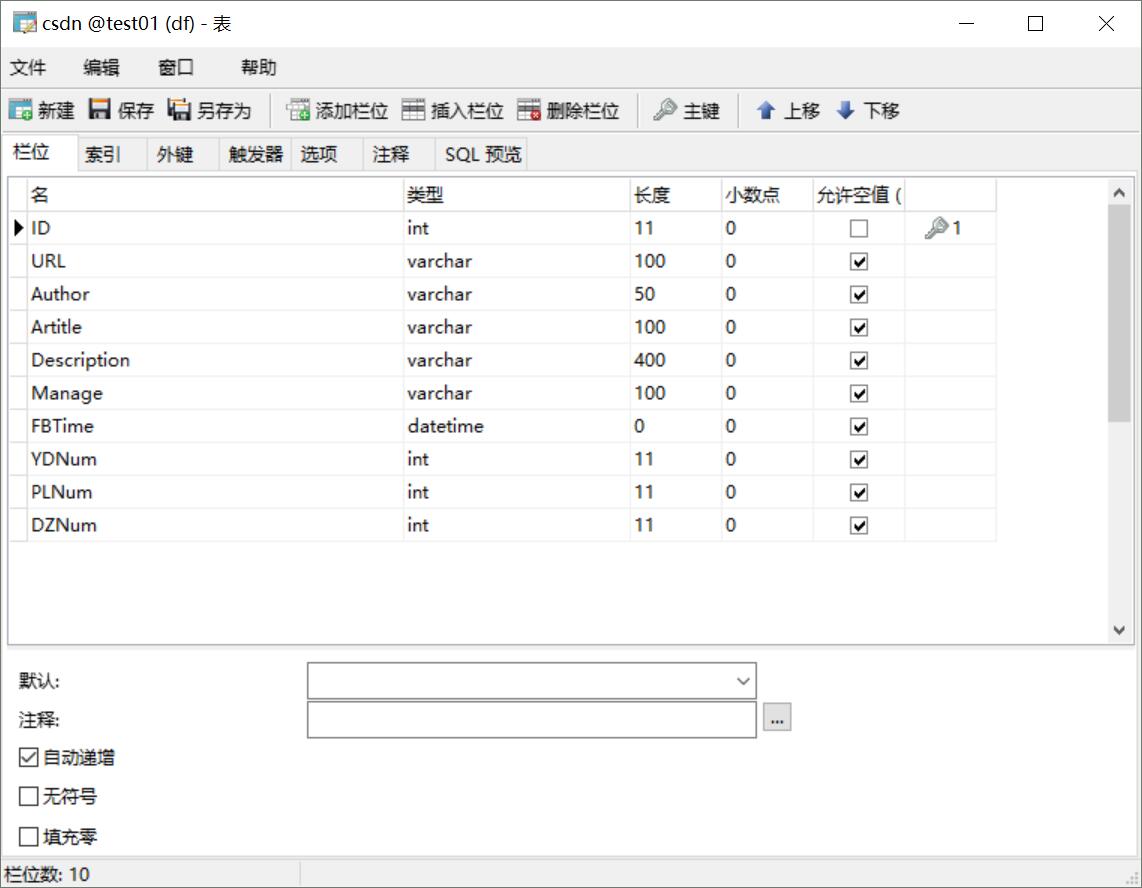
其中,python調用MySQL推薦下面這篇文字。
[python] 專題九.Mysql數據庫編程基礎知識
核心代碼如下所示:
# coding:utf-8
import MySQLdb
try:
conn=MySQLdb.connect(host='localhost',user='root',passwd='123456',port=3306, db='test01')
cur=conn.cursor()
#插入數據
sql = '''insert into student values(%s, %s, %s)'''
cur.execute(sql, ('yxz','111111', '10'))
#查看數據
print u'\n插入數據:'
cur.execute('select * from student')
for data in cur.fetchall():
print '%s %s %s' % data
cur.close()
conn.commit()
conn.close()
except MySQLdb.Error,e:
print "Mysql Error %d: %s" % (e.args[0], e.args[1])最後希望文章對你有所幫助,如果文章中存在錯誤或不足之處,還請海涵~
提高效率,提升科研,認真教學,娜美人生。
(By:Eastmount 2017-03-13 下午1點半 http://blog.csdn.net/eastmount/)
Tags: 瀏覽器 文章閱讀 Firefox python number
文章來源: